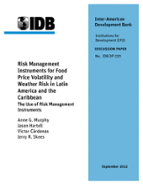Risk Management Instruments for Food Price Volatility and Weather Risk in Latin America and the Caribbean: The Use of Risk Management Instruments
Date
Sep 2012
This report examines some of the implications of price risk and volatility, and weather risks in the LAC region that are important threats to already vulnerable populations. It considers the advantages and limitations of a set of financial instruments for managing these risks; and identifies potential mechanisms for addressing concerns about the socioeconomic consequences of price and weather volatility. In reviewing the innovations that are being tested in the LAC region and around the world, what is striking is that they appear to be disparate and largely piecemeal solutions to the problems of price and natural disaster risk management - they are not integrated. A more efficient and holistic solution should draw upon the recent efforts of coordination among countries within regions. The importance of risk aggregation and pooling combined with the comparative advantage of International Financial Institutions to access capital and work in a regional context, suggests a strategy to develop a fully multicountry approach to risk management. This strategy calls for establishing a Regional Asset Management Platform (RAMP) that integrates central stakeholders and develops pricing and measurement tools for extreme weather risk management and price volatility in a more efficient fashion. Global drivers of price volatility for major commodities can be managed using international futures exchange markets to some extent. However, regional climate anomalies will also mean that individual countries can suffer price volatility that represents a basis risks when using international futures markets. Thus, combining risk transfer products for regional climate anomalies with the use of careful hedging strategies for global volatility may offer better risk management strategies for either lower than expected prices that adversely affect producers or higher than expected prices that adversely affect consumers.



